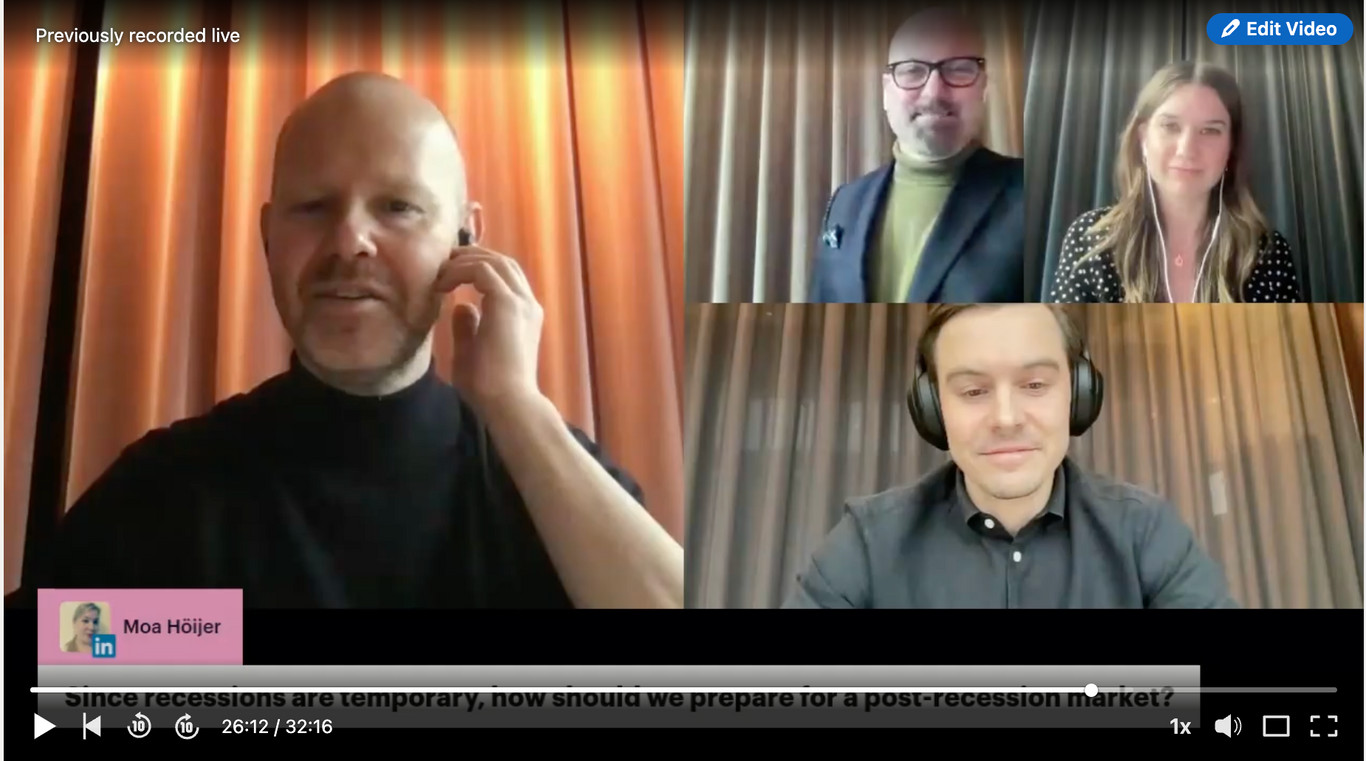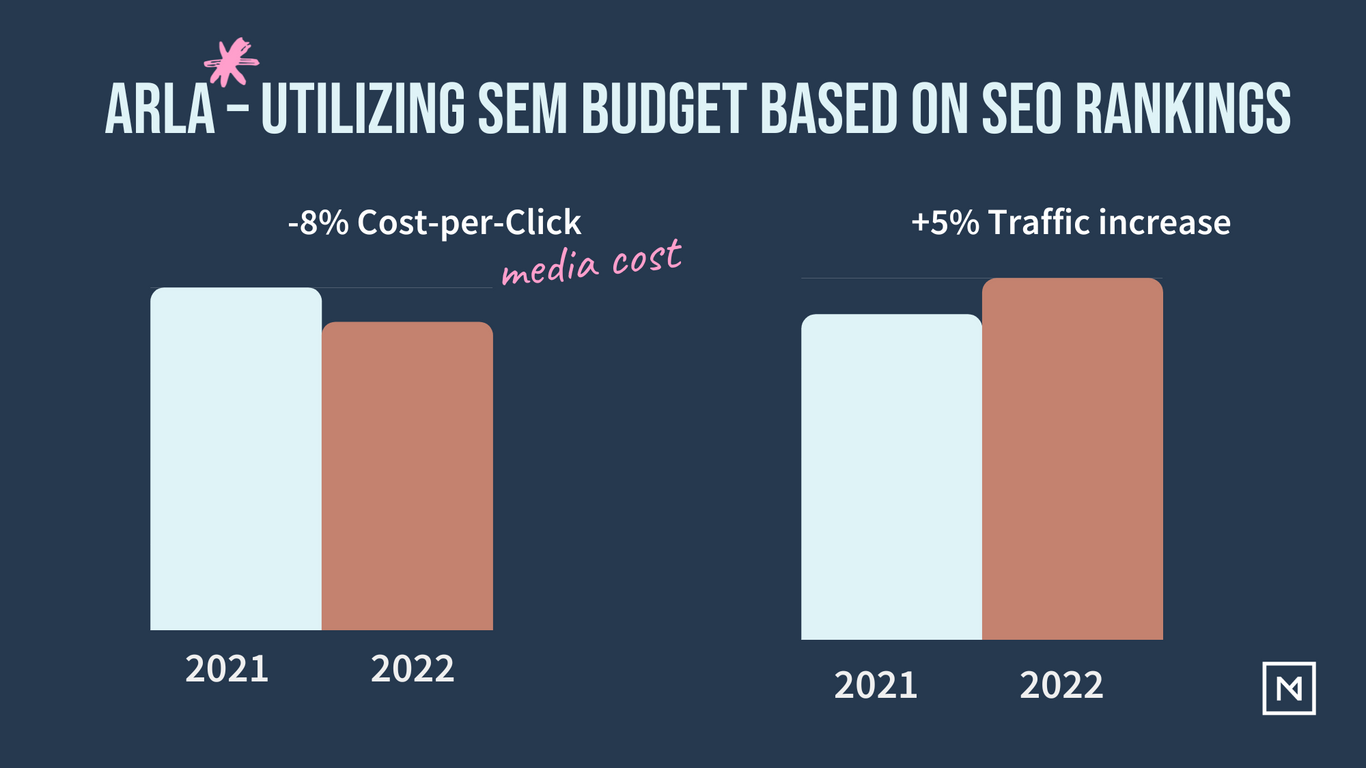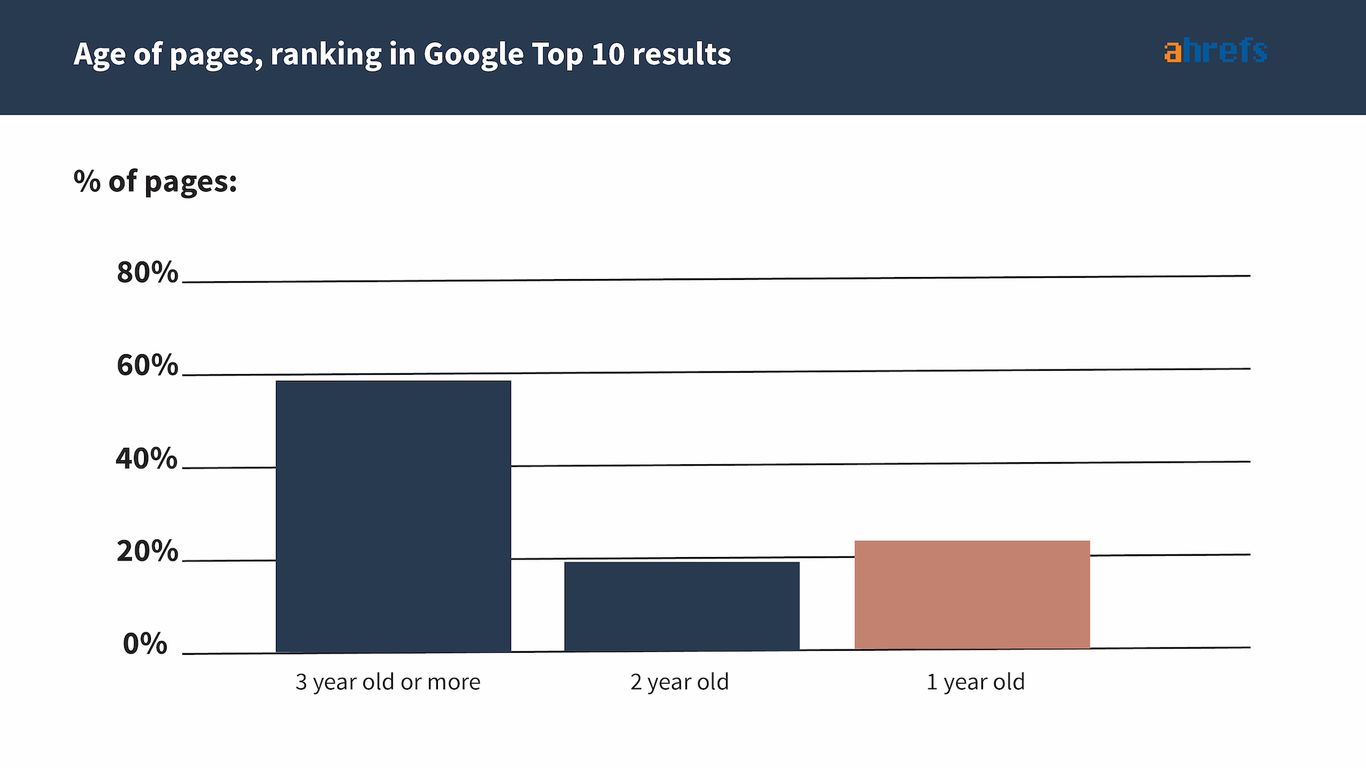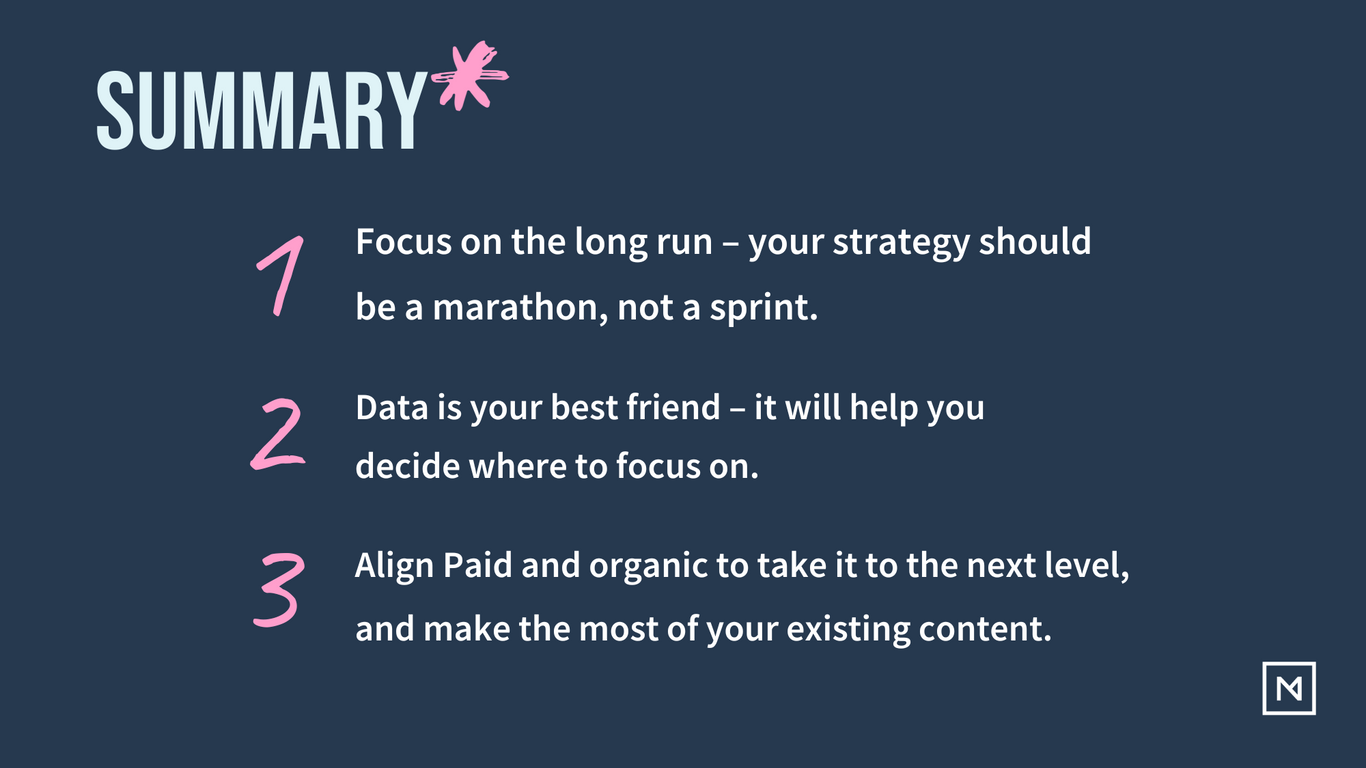Service Development
Nordic Morning Talks: Recession-Proof your Digital Marketing
02/21/22
On February 16th, we hosted the seventh session in our Nordic Morning Talks LinkedIn Live series. These sessions are dedicated to discussing emerging business challenges in the field of digital and a space to showcase some of our projects with some of our clients.
In this session, Head of Strategy Stefan Parker, Nordic SEO Lead Coen van der Heijden, Paid Media Consultant Agnes Ågren, and Project Manager and Client Director Tomas Wihlborg shared key actionable tips to recession-proof your digital marketing strategy.
In this session, you will learn:
- Common pitfalls when entering a recession
- Why digital marketing is crucial during a recession
- How to recession-proof your digital marketing strategy
- The activation side: Essential tips from SEO and Paid Media
If you prefer to watch the session, click here

Tomas Wihlborg (TW): Hello everybody, and welcome! Today’s main question is: How can you optimize your digital marketing budget during less good times? And how can you turn these troubled times into an opportunity?
We will try to give you the answer on this today, in our first Nordic Morning Talks of 2023! My name is Tomas and I am your host today.
In these events we continuously share knowledge with you – our clients and prospects – but also with our colleagues within the agency.
Now, Today we will dig deeper into how you can approach the current downturn in our society – in your role as a marketer. By taking a look at the data driven content-process, and your most important tools for insights – you might as marketer stay ahead of the game.
So our goal is to give you an advantage both in your marketing planning and business development.
To make some sense out of this – we have invited no less than 3 great colleagues of mine, real experts!
Let’s kick things off and give you some background to this talk.
We all know we have some dire times at the moment. Cost of living is rising – with fuels, energy, food and bank interest-rates soaring, not in our favour. And at the same time, inflation decrease the value of our salaries. At the very same time we have a war in Europe, and other instability factors on a geopolitical scale. Putting marketing strategy in this context:
What is the typical reaction and action taken by companies in these kind of times?
Stefan Parker (SP): Most people have incomes and expenses. There is a simple economic model for you. When times get bad and it looks like less money will come in, people tend to look into what they are spending their money on.
Of course companies consist of humans with human behaviour. Cutting cost is an important instrument. But some companies are tempted to go into survival mode and cut all the expenses they see, almost without prejudice.
Budget cuts under survival mode tend to be directed at more long term investments or expenses. Marketing department is seen as one of those investments.
Cutting cost in crisis sounds reasonable enough for most people. But are there any downsides or missed opportunities in this mindset?
Coen van der Heijden (CH): I agree with Stefan on that it is unfortunate that marketing is often seen as a cost, and not as an investment.
Companies need to understand that by eliminating or even scaling down their marketing efforts, just for the sake of cutting cost, they could negatively impact their brand awareness and a potentially lose market share.
Instead I recommend considering your strategy more as a marathon, and not as a sprint. And with a strategy that makes sense, you will likely reap the rewards in the future if you invest today.
Agnes Ågren (AÅ): It is easy to be short sighted and focus on lower-funnel traffic and quick conversions. But it is important to keep feeding the entire funnel. You need to keep new customers coming in as well as strengthen your relationship with existing ones. From a paid perspective, you cannot trust organic to capture the traffic, when scaling down your campaigns, if you don’t rank well enough or have enough reach, instead, your competitors will be the winners. They will become the brand potential customers rely on and interact with.
What could be the main reasons for thinking diffently?
Agnes said those magic words short sighted. When a recession is coming on it’s easy to forget that they typically last about a year.
Trust and credibility is so important to companies. And if you stop working on your content and branding it’s hard to keep that credibility as a stable company that clients want to keep on cooperating with.
Just as an example: The companies that continued to market throughout the recession of 2008 gained almost four times more brand visibility than those that cut budgets. They also had momentum when times got better.
"So, there are opportunities in a crisis as well. Big companies are made in a recession."
Uber, WhatsApp, AirBNB, Groupon (theses are of course affordable services). They kept on. They saw the opportunity.
Is digital marketing even more crucial during a recession, in relation to other marketing disciplines?
CH: That is a good point. And yes, companies should always be using data to make more informed decisions. However, recessions are especially volatile and this often impacts the spending power and the behavior of lots of customers.
For companies this is a crucial time to reassess, to understand whether their marketing strategy still holds up or if they need to pivot. Especially during times of a recession, this could really give companies an edge on their competition.
Besides re-evaluating a marketing strategy, Stefan, are there other ways of being more effective within digital marketing?
SP: That really depends on what sort of products or services you are offering. One example: If you are offering essential products you are in a different place than if you are offering exclusive ones. In the latter case you might want to look at your media mix, for example. And maybe focus on brand building activities and not as much on activation.
This gets kind of complicated if your company owns several brands in different tiers of exclusivity. Also look att products like sweets, crisps, biscuits etc. They might not be essential. But for some people they are an affordable indulgence during bad times.
But it is clear that all sorts of insights get more important than ever. And just to answer the question: A content audit is a good place to start. It will let you review the content you’ve already got and reuse and repurpose the assets that perform well.
AÅ: Digital marketing is cost-effective in general, and if competitors fall out, the costs of media are likely to decrease. But we are still struck by inflation, which means that you need to be smart with your investments.
Digital marketing is also easily measured, and you are most likely sitting on a huge amount of data to give you insights about your content and your audiences. This can really help you identify what to focus on, so you should utilize that! And also ask yourself, or the data, if your customers’ needs have changed? Perhaps you need to shift focus in your offering and highlight other products than previously, or adjust the messaging in order to meet your customers’ new needs.
You touched on activation before: What are you most essential tips from a SEO and Paid Media-point of view?
AÅ: So I mentioned cost-effectiveness, and paid media may be cost-effective, but there are still costs attached to it. For organic channels, the investment lies mainly in the work, but for paid media you also have the cost of media tied to it.
With this in mind, you should use your current data to get insights on how your marketing efforts perform. Make sure you optimize according to the best-performing channels and best-performing assets. This will make sure you spend your money wisely, and by meeting your customers’ needs, you are more likely to get that return on your investment.
In addition to that, this is also a great opportunity to take the collaboration between paid and organic to the next level.
Do you have an example?
AÅ: For one of our customers, Arla, we looked at both paid and organic search in order to find synergies. What we ended up doing is that we decided to stop purchasing traffic on keywords that perform well organically. So we wanted to capture that previously paid traffic organically instead, and focus on giving the poorer-performing keywords a higher visibility on Google. By setting this in motion, we managed to grow the overall traffic from search to the pages, while at the same time decreasing the cost of media.

Coen, would you like to add something here, for our audience to use in there everyday work?
CH: Besides looking for efficiencies between paid and organic search efforts, another cost effective approach is to focus on getting the most out of existing content instead of creating something new.
Reusing existing content has several advantages over new content. And let’s start off with the most obvious one; where reusing content can be beneficial in terms of saving both time and money, as it eliminates the need to create something from scratch.
Another advantage of focusing on existing content rather than on creating something new comes from an activation point of view. Most marketeers are aware that they do need to rank on the first page to even stand a chance of a searcher actually clicking on their search results. But they often underestimate the time it takes for new content to rank well in organic search.
This is confirmed by a study carried out by Ahrefs, which showed that only 22% of the pages that rank on the first page were created within 1 year ago. So for the majority of pages it takes longer; it can take up to 2, 3 or some cases even longer for a page to end up on that first page.

And this make quite a lot of sense. If you think about the process behind it, Your page first needs to be discovered by search engines; once discovered, they will try to understand what your page is about; they then have to compare how relevant and trustworthy it is compared to what they already have in their database.
If we compare existing content to this, it is like getting a head start. Search engines are most likely already aware of this content, they know what a page is about and how it stacks up against other sites in their database.
So how do you go about this, with what existing content do you start?
CH: It all starts with having a very clear overview of what content you have on your site.
There are a lot of companies out there who have not mapped out what each page is about, what it is targeting, how it is performing and how many people you can potentially reach with it. And without such an overview, how can you effectively market your recession proof strategy, if you don’t know what assets can help with this?
In the SEO industry this is referred to as keyword mapping. And besides improving your organic search visibility it can be used for far more. For instance, as Agnes showed in her example, its organic ranking data can be used to adjust paid campaigns to lower campaign costs, without negatively impacting visibility.
It essentially helps companies to build a strong foundation. Building this foundation is something we at Nordic Morning specialize in. You can really tailor it to the needs of your organization. But the main goals are to support a data driven way of working, help with prioritization and simply get better results with your content.
TW: Coen, thank you so much for those thoughts on how a keyword map can help companies to get more out of their existing content.
Takeouts and Learnings
TW: If you would share one major takeout and learning each, for our audience to remember…what would that be?
SP: As always, make sure you know your market. Gather the data and create insights to solve peoples problems. Brand-wise this is your chance. When everyone else slam the breaks, be the one that overtakes the competition. There is a time after the recession.
AÅ: My takeout would be to make sure you utilize your data for targeting and Return On Investment optimization to stay ahead of competition and really make the most of your marketing efforts.
CH: It all comes down to using data to understand whether your marketing strategy still holds up in times of a recession. Maybe it does, maybe it doesn’t. But at least use data to make more informed decisions.
TW: With these takeouts – I would like to try to summarise very short in three points for all to bring along in your daily work and long term planning:

Live questions
Moa: Recessions are temporary: how should we prepare for a post-recession market?
SP: Keep the data and insights coming in - know your market and what's happening in society in general. Everything changes all the time.
Keep your eyes on the road. Don’t get surprised by the up or down turn. Have a long term strategy.
Be prepared to change your strategy as you go along.
Conclusion - be prepared for both good and bad times.
Emelie - What are the most effective channels for digital marketing during a recession?
CH: This depends on many different factors. For instance, are you trying to activate push or pull content? With push content, your target audience is not yet aware of a certain product or that a certain piece of information can help them, paid media channels are most often more effective.
But if your target audience is actively searching for what you have to offer, organic search could be the way to go. Though in most cases we recommend choosing combination of different channels for the ideal activation mix.
Jonathan: How important is brand awareness and trust with clients in order to continuously improve and work on your digital marketing during a recession?
SP: The short answer: It's really important with brand awareness. It all comes back to what we were talking about. The survivor mode is that, first of all, if you keep on marketing, you will not lose the feeling of stability. You want to show you're a stable partner, especially when it comes to providing services, because then you want this long term relationship with your clients or customers.
If you're not working on your content during all this time, you'll lose that credibility. You want to prove people that you're in this for the long haul, because clients want to cooperate and partner up with stable companies.
Carl Fredrik Lindval, Senior Media Consultant at Nordic Morning, respons to our last question:
Jonathan: What role do you think TikTok will have in B2B marketing the upcoming years?
Carl Fredrik Lindval:
- Brand awareness and engagement:B2B companies could potentially use TikTok to create entertaining and informative videos that showcase their brand and products, and engage with their target audience, however, targeting is limited which makes it challenging to know exactly who you’re talking to.
- Talent acquisition: B2B companies could use TikTok as a platform to attract and recruit talent. For example, they could create videos that showcase their company culture, employee perks, and job opportunities.
- Education and training: TikTok could be used as a platform to create short-form educational videos that teach their employees and customers about their products, services, or industry trends.
It’s important to note that the use for TikTok in the B2B industry are still rather speculative. However, it’s great to experiment to understand what works for your brand as there’s no one frame that fits all so consult with Nordic Morning, set a clear goal and some A/B testing and activate your campaign to learn how it works for you.
Time's up! We at Nordic Morning are happy that you have attended our Talks.
Reach out to us if you need help with your communication challenges. With that, have a really good day, and see you soon again!



